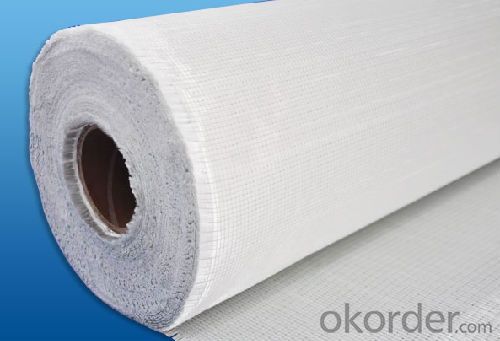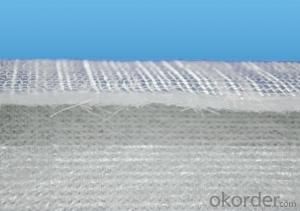Fiberglass Mat Tissue Unidirectional Fabric 350gsm 1000mm
- Loading Port:
- Shanghai
- Payment Terms:
- TT or LC
- Min Order Qty:
- 2000 kg
- Supply Capability:
- 50000 kg/month
OKorder Service Pledge
OKorder Financial Service
You Might Also Like
Process
Fiberglass unidirectional fabric is the product combining the roving in certain angel of 0 ℃ or 90 ℃ with polyester yarn.
Properties
• Fiber straight arranged, fiber strength be ultimately used.
• No powder or emulsion, sink quickly, easy to operate.
• Easy to design, high strength in one direction.
Applications
Mainly be used as reinforced materials in the composite material industry.
• Matrix: unsaturated polyester resin, vinyl ester resin, epoxy resin and phenolic resin etc.
• Craft: winding, pultrusion, hand lay up, etc.
• Ultimate products: storage tank, tube, pultruded profiles, FRP body of boat, etc.
Specifications
specifications
Fibre type
0°Roving
90°Roving
Overall weight
Width
(g/㎡)
(g/㎡)
(g/㎡)
(mm)
EDW227
E-Glass
—
227
227
1524
EDW350
E-Glass
—
350
350
1524
EDW450
E-Glass
—
450
450
1524
EDJ600
E-Glass
480
120
600
1524
EDJ800
E-Glass
600
200
800
1524
EDJ1000
E-Glass
600
400
1000
1524
Packaging: Wrapped in PVC and placed within a cardboard carton.
Images of Unidirectional
FAQ of Unidirectional
1. Why Choose us?
CNBM is a stated own company, provide the guarantee for the best quality, best service and safety business.
2. How will we guarantee the quality?
a, ISO 9001-2008 quality control system;
b, Strict and regular quality control in production;
c, Inspeciation when loading into container before shippment;
d, Sample stock for one year for quality tracing and record.
3. What is your MOQ?
Our MOQ is one pallet.
4. Can you provide sample?
Yes, samples are in stock. we can offer free sample for you.
5. Payment terms?
We can accept L/C, T/T etc.
6. Do you offer OEM service?
Yes, we can print customers’ logo on the packaging;
And the size and specification can be produced and design according to your demand.
- Q: Can fiberglass mat tissue be used for insulating concrete forms (ICFs)?
- Fiberglass mat tissue is indeed suitable for insulating concrete forms (ICFs). By acting as a reinforcement layer, it can be directly applied to the surface of ICFs. Its primary function is to enhance the strength and durability of the concrete, while simultaneously improving the insulation properties of the ICF system. To secure the fiberglass mat tissue to the ICF surface, it is typically embedded in a thin layer of adhesive or mortar. This combination of materials creates a robust and insulated barrier that effectively reduces heat loss and enhances energy efficiency in buildings. Moreover, the lightweight and easy-to-handle nature of fiberglass mat tissue makes it a convenient choice for ICF installations.
- Q: Can fiberglass mat tissue be used for HVAC insulation?
- No, fiberglass mat tissue is not suitable for HVAC insulation. It is primarily used for reinforcing materials in construction and composite manufacturing. HVAC insulation requires specific materials with thermal resistance properties to effectively control temperature and reduce energy loss.
- Q: Does fiberglass mat tissue require any special treatment for UV resistance?
- Special treatment is required for UV resistance when using fiberglass mat tissue. This tissue is composed of fine strands of glass fibers which can be easily damaged by prolonged exposure to ultraviolet (UV) radiation. The degradation of the fibers due to UV rays can result in a reduction in strength and dimensional stability. To enhance the UV resistance of fiberglass mat tissue, manufacturers often apply a unique coating or treatment to the material. This treatment serves to safeguard the fibers from UV radiation and prevent their deterioration. The specific treatment employed may vary based on the intended application and the desired level of UV resistance. Furthermore, it is important to acknowledge that despite the special treatment, fiberglass mat tissue may still experience some degree of UV damage over time. It is therefore advised to minimize direct sunlight exposure whenever possible to ensure the longevity and performance of the material.
- Q: What is the expected lifespan of fiberglass mat tissue in underground applications?
- The expected lifespan of fiberglass mat tissue in underground applications can vary depending on various factors such as the specific conditions of the underground environment, the quality and thickness of the fiberglass mat tissue, and the level of maintenance and care provided. However, on average, fiberglass mat tissue is known for its durability and longevity, making it suitable for underground applications. In general, fiberglass mat tissue is designed to be highly resistant to corrosion, moisture, and other environmental elements commonly found in underground settings. This makes it a reliable choice for applications such as underground pipes, tanks, and other infrastructure where protection against deterioration is crucial. With proper installation and regular maintenance, fiberglass mat tissue can have an expected lifespan of 50 years or more in underground applications. However, it is essential to note that this estimate can vary depending on the specific conditions and usage of the fiberglass mat tissue. To ensure the maximum lifespan of fiberglass mat tissue in underground applications, it is recommended to follow industry best practices, such as proper installation techniques, regular inspections, and addressing any issues, such as cracks or damage promptly. By doing so, the lifespan of fiberglass mat tissue can be extended, providing long-term reliability and durability in underground settings.
- Q: What is the flexibility of fiberglass mat tissue?
- The flexibility of fiberglass mat tissue refers to its ability to bend, conform, or mold to different shapes or surfaces without breaking or losing its structural integrity. The unique properties of fiberglass, such as its high strength-to-weight ratio and dimensional stability, allow the mat tissue to be flexible while still maintaining its strength and durability. This flexibility makes fiberglass mat tissue a versatile material that can be used in a wide range of applications, including automotive parts, construction materials, and boat manufacturing. Additionally, the flexibility of fiberglass mat tissue enables it to be easily cut, shaped, or layered to meet specific design requirements or fit into complex or curved surfaces.
- Q: Can fiberglass mat tissue be used for making lightweight automotive parts?
- Yes, fiberglass mat tissue can be used for making lightweight automotive parts.
- Q: What are the different reinforcement patterns available for fiberglass mat tissue?
- Some different reinforcement patterns available for fiberglass mat tissue include random pattern, grid pattern, and diamond pattern. Each pattern offers different levels of strength and durability depending on the specific application and requirements.
- Q: How does the fiber orientation of fiberglass mat tissue affect its strength?
- The fiber orientation of fiberglass mat tissue plays a significant role in determining its strength. Fiberglass mat tissue is a composite material made up of randomly distributed glass fibers held together by a binder material. The strength of this material is highly influenced by the orientation of these fibers. When the fibers in fiberglass mat tissue are randomly oriented, it results in a material with isotropic strength properties. This means that the material exhibits similar mechanical properties, such as tensile strength and stiffness, in all directions. Random fiber orientation provides a balanced distribution of load-bearing capability throughout the material, making it resistant to both tensile and compressive forces from any direction. On the other hand, if the fibers in fiberglass mat tissue are oriented in a specific direction, it creates an anisotropic material with directional strength properties. In this case, the material becomes stronger and stiffer along the direction of the fibers, while its strength decreases in other directions perpendicular to the fiber orientation. This anisotropic behavior is due to the fact that the fibers primarily carry the load, while the binder material acts as a support and provides cohesion between the fibers. By manipulating the fiber orientation during the manufacturing process, it is possible to tailor the strength and performance characteristics of fiberglass mat tissue to specific applications. For example, in applications where strength is required in a particular direction, such as in the construction industry for reinforcing concrete or in the aerospace industry for structural components, the fibers can be aligned to provide maximum strength along the desired load path. In summary, the fiber orientation of fiberglass mat tissue directly affects its strength. Random fiber orientation results in isotropic strength properties, providing balanced strength in all directions. Conversely, specific fiber alignment creates anisotropic strength properties, enabling enhanced strength along the direction of the fibers. This ability to control the fiber orientation allows for the customization of fiberglass mat tissue to meet the specific strength requirements of various industries and applications.
- Q: How does fiberglass mat tissue contribute to the strength and durability of composite materials?
- Fiberglass mat tissue plays a crucial role in enhancing the strength and durability of composite materials. Firstly, the mat tissue acts as a reinforcement component by providing additional strength and rigidity to the composite structure. The fibers within the mat tissue are typically made of glass, which has high tensile strength and stiffness. These fibers are randomly oriented, creating a three-dimensional network that distributes and transfers stress throughout the composite material. This network of fibers helps to resist cracks and fractures, thereby increasing the overall strength of the composite. Furthermore, the mat tissue also acts as a barrier against delamination, which is a common issue in composite materials. Delamination refers to the separation of layers within the composite, which can weaken its structural integrity. The fiberglass mat tissue prevents delamination by bonding the layers together and improving the adhesion between them. This increased adhesion reduces the likelihood of interface failure and enhances the overall durability of the composite material. Moreover, fiberglass mat tissue helps to improve the impact resistance of composite materials. The random fiber orientation within the mat tissue creates a crisscross pattern, which enhances the composite's ability to absorb and distribute impact energy. This characteristic makes the material less prone to damage from external forces, such as impacts, vibrations, or mechanical stress. In summary, fiberglass mat tissue significantly contributes to the strength and durability of composite materials through reinforcement, delamination prevention, and enhanced impact resistance. Its unique characteristics and properties make it an essential component in various industries, including automotive, aerospace, construction, and marine, where the need for strong and durable materials is crucial.
- Q: Does fiberglass mat tissue provide any electrical insulation?
- Yes, fiberglass mat tissue does provide electrical insulation. It is commonly used as a reinforcement material in electrical applications due to its high dielectric strength and insulating properties.
Send your message to us
Fiberglass Mat Tissue Unidirectional Fabric 350gsm 1000mm
- Loading Port:
- Shanghai
- Payment Terms:
- TT or LC
- Min Order Qty:
- 2000 kg
- Supply Capability:
- 50000 kg/month
OKorder Service Pledge
OKorder Financial Service
Similar products
Hot products
Hot Searches
Related keywords




























